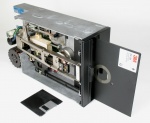Security and Storage Mediums
From Computing and Software Wiki
(→Compact Discs) |
(→Compact Discs) |
||
| Line 16: | Line 16: | ||
=== Compact Discs === | === Compact Discs === | ||
| - | With the introduction of Compact Discs (more commonly known as CDs) the first real, mainstream alternative to Floppy disks made its appearance. The very first Compact Disc that was created for commercial use was produced at a Philips factory in Langenhagen, Germany on August 17, 1982. [[http://en.wikipedia.org/wiki/Compact_discs#History]] A standard CD today can hold between 74-80 minutes of audio, or 650-700 MB of data. By using "burning" technology, where data would be essentially carved into the data tracks, allowed for a fairly secure storage of data by making it read only. However later on after the release of CD-Rs (Recordable CDs) brought CD-RWs into the mix (ReWritable CDs) | + | With the introduction of Compact Discs (more commonly known as CDs) the first real, mainstream alternative to Floppy disks made its appearance. The very first Compact Disc that was created for commercial use was produced at a Philips factory in Langenhagen, Germany on August 17, 1982. [[http://en.wikipedia.org/wiki/Compact_discs#History]] A standard CD today can hold between 74-80 minutes of audio, or 650-700 MB of data. By using "burning" technology, where data would be essentially carved into the data tracks, allowed for a fairly secure storage of data by making it read only. However later on after the release of CD-Rs (Recordable CDs) brought CD-RWs into the mix (ReWritable CDs) which allowed users to reburn data onto the medium, making it easier to update/modify/erase data at will. While this did help the medium in terms of cases where repeated transportation of data is needed, it overall makes the data on discs less secure, since it could be modified or important information could be lost if a disc was lost in transit to a person with malicious intent. |
Lead to the introduction of many different types of copy protection techniques: | Lead to the introduction of many different types of copy protection techniques: | ||
* Dummy Files (Illegal file headers) | * Dummy Files (Illegal file headers) | ||
Revision as of 00:17, 2 December 2007
Storage mediums today, whether they be in the form of CDs, DVDs, USB Keys, or another form, are one of the primary methods of transferring information on a small scale. Since the introduction of floppy disks in 1971, storage mediums have been accepted by society as an integral part of the technological age and in turn, advances are made frequently in order to furthur fulfill the end-users needs.
Contents |
Benefits of Storage Devices
- Data Protection
- Ease of Use
- Easy to Transport Information
- Relatively Cheap and Efficient
Example Storage Devices
Floppy Disks
The introduction of Floppy Disks was one of the first widely accepted form of use of an external device to act as a storage medium. Althought "Floppy" Disks are fairly rigid in composure, the name actually comes from the very first released disk, 8-inch - IBM 23FD[[1]], in 1971. This disk had a capacity of approximately 79.7 KB, and was, as the name implies, soft and floppy in nature. With evolution of technology, and the drive to advance, in 1987 the most widely used form of Floppy Disc (the 3.5" High Density Disk) hit the market as the fast, easy, affordable way to transfer small amounts of data.
As for the security used to protect Floppy Disks, the only real measure was a toggle switch, used to set the disk from full access, to read only. This only really accomplishs protection against unintentional modifications to data on a disk, and did not take any malicious intent, or other kinds of integrity, confidentiality, or availability violations into account.
Compact Discs
With the introduction of Compact Discs (more commonly known as CDs) the first real, mainstream alternative to Floppy disks made its appearance. The very first Compact Disc that was created for commercial use was produced at a Philips factory in Langenhagen, Germany on August 17, 1982. [[2]] A standard CD today can hold between 74-80 minutes of audio, or 650-700 MB of data. By using "burning" technology, where data would be essentially carved into the data tracks, allowed for a fairly secure storage of data by making it read only. However later on after the release of CD-Rs (Recordable CDs) brought CD-RWs into the mix (ReWritable CDs) which allowed users to reburn data onto the medium, making it easier to update/modify/erase data at will. While this did help the medium in terms of cases where repeated transportation of data is needed, it overall makes the data on discs less secure, since it could be modified or important information could be lost if a disc was lost in transit to a person with malicious intent. Lead to the introduction of many different types of copy protection techniques:
- Dummy Files (Illegal file headers)
- Illegal Sectors (Error Detection Code, using checksums)
- Illegal Sub-Channels (Left over data filled)
Digital Video Discs
USB Keys
Security Measures
References
Security Risks Associated With Portable Storage Devices
Demand for Personal Storage Devices to Grow
See Also
External Links
CD-Lock
CD and DVD Copy Protection
Floppy Disks
SecuROM
SafeDisc
--Cavaliaj 17:20, 1 December 2007 (EST)

